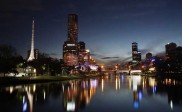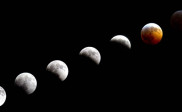The Importance of Framing in Photography
Framing is such a basic photographic notion, that sometimes it’s neglected and not given the worth it deserves. You can have the most sophisticated SLR camera and the best lens, but if you don’t get your framing right you won’t be happy with the photos you get.
This article will try to give you some tips and rules that can help you get great images through framing them correctly. Although some of the rules need to be broken in some instances, try to follow them most of the time and you will see the difference between a common snapshot and a well thought photograph.

Rodrigo Baptista
Horizontal vs. Vertical:
The first choice you will be faced with, unless you are shooting in a square format, is whether to take the photograph vertically or horizontally. This is actually a crucial choice, and if you choose the wrong option your photo won’t have the impact it would have had with the other choice. So, how to frame, horizontally, or vertically?
Horizontal framing:

Photo by Yassine Hakimi
This is, in general, the most popular way to frame photos, as it suits most of the subjects. Another thing that makes it so abundant is that it is close to how we perceive things with our eyes (horizontally). Horizontal framing can be appropriate for shooting landscapes, group photos, movement, etc.
Vertical Framing:

Photo by Yassine Hakimi
The human eye is less accustomed to vertical framing, because it has to scan it from top to bottom. This will lead the eye to not pay much attention to elements placed on the borders of the frame. So, vertical framing is used less than horizontal framing and is more appropriate for shooting portraits, architecture, and scenes where vertical lines play a predominant role in defining them.
Types of Shots:
This concept is mainly a cinematographic one, but it can be used well to explain framing in photography. After all, films are moving pictures. So, in cinema we can find 3 basic types of shots: long shots, medium shots and close-up shots
This concept of shots determines how much frame space the subject takes. The subject is usually a person but the concept can be applied to any type of subjects.
The long shot:

Photo by Yassine Hakimi
In this type of framing the subject is seen in its entirety within a much bigger environment. Usually, with long shots, wide angle lenses are used and the subject is shot from a consistent distance. This type of framing works well when shooting landscape and environmental portraits.
The medium shot:

Photo by Yassine Hakimi
With medium shots, the subject takes a more important role in the frame and is not framed as a whole. For example, if your subject is a person you would only include him/her from head to knee in the frame. In this kind of framing the environment is given less interest and focus is put on the subject.
The close-up shot:
This framing usually includes only a part of the subject. If it’s a person only the shoulders and head are included in the frame and the background takes even less relevance in the photo
The big close-up shot:
The big close-up shot consists of framing an important part of the subject and focusing only on that part, a face for example. In this type of framing the background is not important if existent at all.
The extreme close-up shot:
This shot concentrates on a small detail of the subject and fills the frame with it. With this framing there is an isolation of an important feature of the subject which will contribute in conveying a stronger meaning than the one channeled through another type of framing. This detail can be a wedding ring, a part of the human body, like an eye, etc.
The Choice of Focal Length:
Your choice of the focal length to be used will affect the way you frame your photos. It may appear that all a change in focal length would do is zoom in or out. But there is a lot more to the choice of focal length. In fact, short focal lengths will allow you to include a lot more of elements in your frame than longer focal lengths. So, long focal lengths will not only zoom in but will also limit the space of your frame.
– Use wide angles (28 to 35mm) when shooting landscape and wide areas. It also might come in handy when shooting in interior settings.
– Medium focal lengths (45 to 50mm) can be used in many situations. They are versatile and they can cover subjects such as sceneries, portraits, still life, etc.
– Telephoto lenses are a good choice for framing portraits and architectural details (70 to 100 mm) and also for shooting distant objects, such as animals (150 to 300mm).
Odd One Out:
It is crucial that you pay close attention and spot any element that might distract the viewer from the subject. Try to get rid of these intruding elements to leave only what is of relevance to the shot in the frame. This can easily be done by moving closer or further from the subject, by zooming in and out, or trying a different camera angle. But, you should keep in consideration that moving closer to the subject and changing the camera angle may alter the perspective of the photo which can change a lot about an image. So, in order to keep the same perspective, opt for zooming in or out.
Cropping:

Photo by Yassine Hakimi
Cropping is a post processing framing technique. It’s better to be used as a last resort. There is nothing like a photo correctly framed at the moment of its capture. But still, one of the merits of cropping is that it can allow you to get many different photos from a single shot, especially that now, most of the cameras have decent resolutions allowing for some extreme cropping.
When you are intending to crop a picture, you should proceed as if you were at the moment of shooting the photo. Think of whether it’s best framed vertically or horizontally, choose how much space you want your subject to take in the frame, and make sure not to let anything distracting inside of the photo.




i learned alot!!
thank you so much!!
xD
thanks for this post , it is very useful 🙂
thank you for all your help i learned a lot
These are beautiful pictures and great examples. Thanks for the help! 🙂